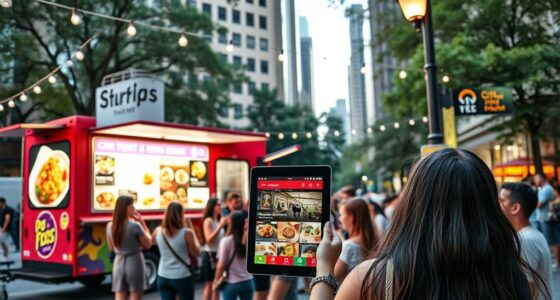To create a brand mascot or persona, focus on developing a character that embodies your brand’s core values and personality traits, making it relatable and memorable. Design a visual identity with consistent colors, style, and branding elements to reinforce recognition. Guarantee your mascot communicates your story across channels, building emotional connections and trust. A well-crafted mascot not only strengthens your brand presence but also becomes a strategic ambassador. Keep exploring to discover how to bring it all together effectively.
Key Takeaways
- Define the brand’s core values and target audience to inform the mascot’s personality and traits.
- Develop a consistent visual identity, including logo, colors, and style, that aligns with brand attributes.
- Create a relatable character with a distinct personality to humanize the brand and foster emotional connections.
- Ensure the mascot can be adapted across multiple channels for storytelling, engagement, and brand reinforcement.
- Use insights such as personality traits and audience preferences to tailor the mascot’s behavior and messaging effectively.

Have you ever wondered how brands build strong connections with their audiences? One powerful way is by creating a brand mascot or persona that embodies the brand’s essence. This approach helps humanize your brand, making it more relatable and memorable. When you craft a mascot or persona, you’re essentially giving your brand a personality—a distinct character that resonates with your target audience. This is where developing a clear brand personality becomes vital. Your brand personality shapes how your mascot or persona behaves, speaks, and interacts. Is your brand playful and fun? Serious and professional? Friendly and approachable? Defining these traits guarantees your mascot aligns perfectly with your overall brand message.
Equally important is establishing a strong visual identity. Your visual identity includes your logo, color palette, typography, and overall design style. When creating a mascot or persona, these visual elements should harmonize with your existing branding to reinforce recognition. For instance, if your brand’s visual identity uses bright, vibrant colors to evoke energy and optimism, your mascot should mirror this through its design and colors. This consistency helps your audience instantly associate the mascot with your brand, creating a cohesive experience. Think of your mascot as an extension of your visual identity; it’s a visual and emotional touchpoint that communicates your brand’s values and personality.
As you develop your mascot or persona, think about how it will engage with your audience. Your mascot should be adaptable and capable of conveying your brand’s story through various channels—social media, advertising, packaging, and more. Make sure it’s memorable, distinctive, and capable of eliciting an emotional response. The more your audience connects with your mascot’s personality and visual elements, the stronger your brand’s presence becomes. Additionally, understanding the 16PF traits can help tailor your mascot’s characteristics to better resonate with target audiences. Remember, consistency is key: every interaction should reinforce your brand personality and visual identity, making your mascot a genuine ambassador for your brand.
Creating a brand mascot or persona isn’t just about adding a friendly face; it’s about strategic storytelling. By carefully crafting a personality that aligns with your brand values and integrating it with your visual identity, you create a powerful tool for engagement and loyalty. When your audience sees and interacts with your mascot, they should feel like they’re engaging with a real, relatable character—someone who embodies what your brand stands for. This emotional connection helps foster trust and builds a lasting relationship, turning casual viewers into loyal customers.
Frequently Asked Questions
How Do I Choose a Mascot That Appeals to My Target Audience?
To choose a mascot that appeals to your target audience, start by understanding their preferences, interests, and values. Think about what resonates with them culturally and emotionally. Select a mascot that reflects these qualities and aligns with your brand’s personality. Consider feedback from your audience or conduct surveys to gauge mascot appeal. Ultimately, your mascot should be relatable, memorable, and capable of forging a strong connection with your target audience.
What Are Common Mistakes to Avoid When Designing a Mascot?
When designing your mascot, avoid clashing colors that can confuse or turn off your audience. Steer clear of unrelatable characters that don’t connect with your target market, as they won’t foster engagement. Make sure your mascot aligns with your brand message and is approachable. Also, steer clear of overly complex designs, which can make your mascot hard to recognize or remember. Keep it simple, relatable, and visually appealing.
How Can I Measure the Effectiveness of My Brand Mascot?
To measure your brand mascot’s effectiveness, track changes in brand awareness and customer engagement. Monitor metrics like social media interactions, mentions, and surveys to see if your mascot boosts recognition. Analyze website traffic and sales during campaigns featuring your mascot. If engagement increases and customers respond positively, your mascot is resonating. Regularly gather feedback to refine its role, ensuring it continues to strengthen your brand’s connection with your audience.
Should My Mascot Reflect Current Trends or Timeless Values?
You should aim for your mascot to reflect timeless appeal, as it provides long-lasting relevance and brand consistency. While trend adaptation can keep your mascot current, it risks losing its core identity if trends shift rapidly. endeavor for a balance: incorporate subtle trend elements that enhance your mascot’s appeal without compromising its timeless qualities, ensuring it resonates now and remains iconic in the future.
How Do I Ensure My Mascot Remains Relevant Over Time?
You guarantee your mascot stays relevant by embracing brand evolution and continually adapting it to reflect changing trends and audience preferences. Stay engaged with your audience through feedback and social media insights, allowing you to refine your mascot’s design, personality, or messaging over time. This active approach keeps your mascot fresh, relatable, and capable of fostering ongoing audience engagement, ensuring it remains a meaningful part of your brand’s identity.
Conclusion
Creating a brand mascot or persona is like giving your brand a personality that sticks in people’s minds forever. When you craft a relatable, memorable character, you’re not just making a logo—you’re building a loyal army of fans who will champion your brand through thick and thin. So go ahead, release your creativity, because a well-crafted mascot can turn your brand into an unforgettable legend that outshines even the brightest stars in the sky!








